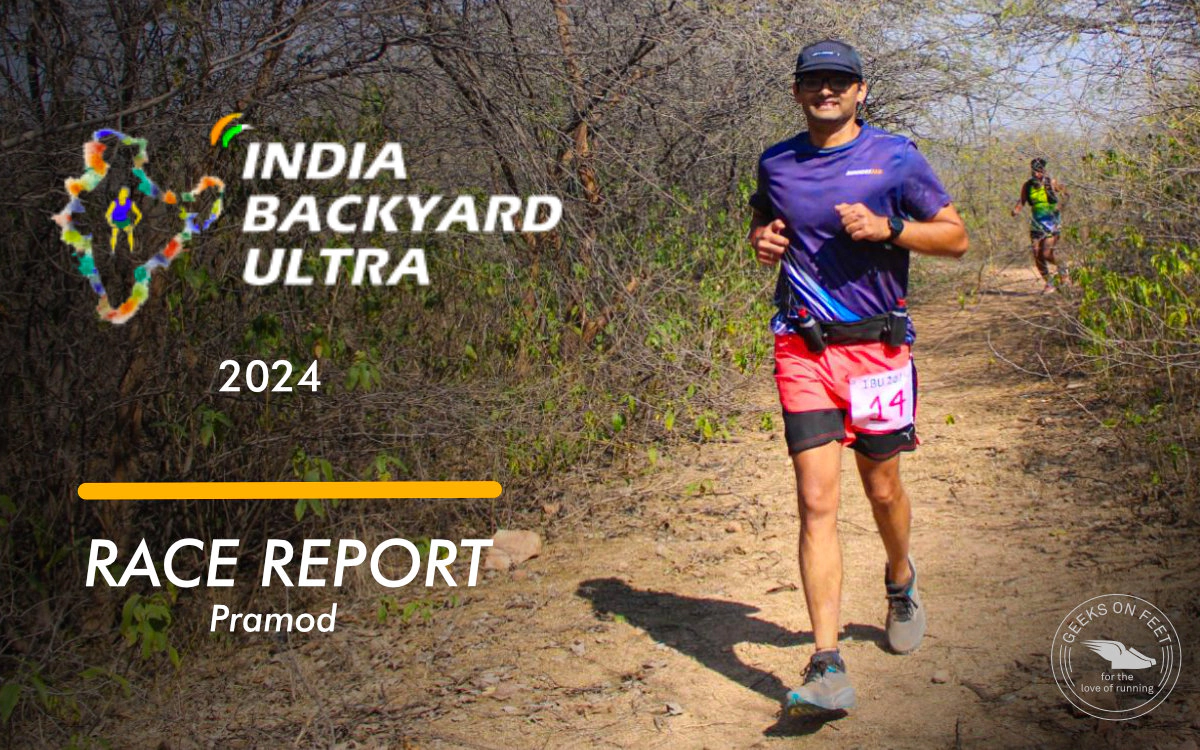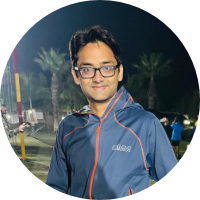
I first heard about the Big Dog’s Backyard Ultra in 2023. This unique event was conceptualized by Lazarus Lake, the creator of the infamous Barkley Marathons in the US.
The format of the race is straightforward: It consists of a 4.1-mile (6.7 km) loop featuring an elevation gain of between 80 to 100 m. Participants must complete each loop within one hour. If they finish early, they wait until the hour concludes to start the next loop. This process repeats indefinitely. Runners who fail to complete a loop within the hour or do not start the next loop are disqualified. The loop is entirely self-supported, and runners must carry all necessary supplies with them and can only access their crew upon completing each loop. The race continues until only one runner remains, who is declared the winner.
My interest piqued, I discovered that this format is also held annually in Gurugram, India, under the name India Backyard Ultra. I signed up last October, making it my second ultramarathon, following my first at the Two Oceans in South Africa, which covers 56 km.
Until November, my training was exclusively focused on marathons which concluded with Tata Mumbai Marathon (TMM). Following TMM on 21st Jan, I had just three weeks until the Backyard Ultra, requiring me to recover quickly, and incorporate some hilly runs, and then taper off.
In the week following the TMM, I ran a total of 55 km. In the second week, I increased my mileage to 62 km, with many back-to-back sessions on hills. During the race week, I put 25 km of mileage before heading to the race. Most of my training was for marathons, the paces were in the range of 4:50 to 5:20 min/ km. But post TMM, slowed it down 5:20 to 6:00/km pace.
My coach, Deepa Nayak, advised me to aim for 8 loops (equivalent to 52 km) and, if possible, extend to 10 loops (67 km) as part of my endurance training for the upcoming Comrades Marathon. In the context of a backyard ultra, this would mean running for 8 to 10 hours.
The organizers arranged an online pre-race briefing to discuss logistics and gear requirements. Only 32 participants would be at the start line, a stark contrast to the thousands of runners in larger races.
Given the varied weather conditions we purchased a tent, and made arrangements for all food and nutrition, aiming for up to 15 loops. After 11 loops it would be dark hence purchased a reflective vest and headlights too.
We arrived in Delhi on February 9th and made our way to the Aravalli hills, opting to stay at a hotel close to the venue. My wife, who is also a runner, accompanied me to serve as my crew for this ultra.
Upon arriving at the venue, we observed other runners setting up their tents, equipped with gas stoves, electric heaters, eggs, and fruits. It quickly became evident that we were underprepared in comparison. Interacting with the other participants, it was clear that this race emphasized quality over quantity. All the runners were seasoned ultra-marathoners boasting various accomplishments. Unlike me, their goal was to be the last person standing. The winner of the previous year’s event in 2023 had completed 30 loops, equivalent to 30 hours of running.
We arrived at the venue at 5:40 AM, the race was to begin at 7:00 AM. It was quite cold at 3 degrees. I just had a light jacket and didn’t bring any gloves so my hands were frozen cold. Both me and my wife looked like popsicles with our hands in the jacket.
Collected the bibs, unlike marathons, there was no special Expo. We just took our hand painted cloth bibs and attached them to my shorts. I wore my club T-Shirt and put on my jacket. For the shoes, since I would be running at a slow pace, I decided to run in Saucony Triumph 21, which provided excellent stability and cushioning.
The organizers had a specific protocol to signal the beginning of every loop: three whistles three minutes before the start, followed by two whistles, then one whistle, before commencing the countdown. So, at precisely 6:57 AM, we heard the three whistles and assembled in the corral. I was equipped with two 100 ml bottles containing Fast&Up electrolyte solution mixed in, secured in my belt for the start.
The race commenced at 7 AM, signaled by the ringing of a bell by the organizer, and we were off. The route featured steep and short elevations and descents for the first 2.5 km.
The path was a worn trail, making it runnable except for a few sections where extra caution was needed due to loose rocks and sand. A mix of concrete and tar roads for the next 2 km. Then, the course led us into the trails of the Aravalli hills. While the sections were runnable, lack of caution could potentially end one’s race.
For the first few kilometers, I maintained a comfortable pace of 6:30 min/km, given that my marathon pace is between 5:10 to 5:15 min/km. Completing the first loop in 44:35 minutes felt a bit fast, but I felt good overall. With almost 15 minutes to spare before the start of the next loop, this break proved to be the most deceptive part of the race. Unlike marathons where your body remains active through the distance, these breaks cool down your body, giving you the sensation of having finished a race.
I completed the second loop in 45 minutes. Being in the early part of the race, I felt great. As a marathon runner, I ran all the hills, while others chose to walk and conserve their energy. In the hindsight, I should have followed their strategy.
By the start of the 5th loop at 12 PM, the escalating heat made each break between loops counterproductive, as returning to the start line became increasingly challenging. My nutrition strategy faltered with a gel and a croissant that disagreed with my stomach. An experienced runner advised me to limit my breaks to no more than 10 minutes and aim for loop times of 50 to 52 minutes.
During the 6th loop, at around 1 PM, I ran out of water midway and finished the loop in approximately 50 minutes. The realization that achieving 15 loops was unrealistic set in as the heat significantly drained my energy, though I still harboured some hope. Continuous updates and advice flowed from my coach and friends to my wife, stressing the importance of solid food since I had been relying solely on gels and water.
After the 7th loop, I had sweet potatoes, a welcome change, though a subsequent attempt to drink Coke also upset my stomach. Persisting into the 8th loop, my pace further dropped to 52 minutes, with the relentless heat showing no signs of abating. By this point, nearly 10 runners had withdrawn. Cramping in my hamstrings and quads plagued me during the 9th loop. Finishing the loop as the last runner in 56 minutes, I was on the brink of giving up when the whistle signalled the start of the next loop with just three minutes to prepare.
Determined, I started on the 10th loop. Despite the demoralizing sight of other runners appearing effortlessly swift, I pressed on. The final stretch required me to overcome immense pain and push my pace to 5:50/km. Hearing the two-minute whistle just 300 meters from the finish, I mustered all my strength and completed the loop with only 20 seconds to spare.
My narrow finish gained me some admiration and felt extraordinarily rewarding. With only 17 runners continuing beyond the 10th loop, I rate my performance as a novice ultra-runner was decent.
After the race, the organizers presented me with a large coffee mug, emblazoned with “DNF” in bold letters. Although it marked my first Did Not Finish, I felt a sense of pride in what I had accomplished. Additionally, one of the runners generously sponsored jackets for all participants, a gesture that truly underscored the sense of camaraderie among us.
The winner of this year’s edition, Ankit won with 29 loops, which was incredible.
Falling in love with this race format was an unexpected outcome for me. Race Director Lalitha and her team executed a phenomenal job organizing the event. This race is a genuine test of endurance and pace management, teaching me a valuable lesson: unlike marathons, where the emphasis is on maintaining pace and resisting the urge to walk, walking in this format is a crucial and strategic element.
I’m already looking forward to returning next February. Although I didn’t reach my lofty goal, I’m satisfied with surpassing the target set by my coach, marking this finish a satisfying personal achievement, just 3 weeks after my marathon.
For runners eager to explore ultra distances or push their limits without the pressure of specific distance targets, backyard ultra format offers an exceptional challenge. More information can be found here

Pramod Venkatesh trains with Runners 360, and is coached by Coach Deepa Nayak. He has been running for 2 years, and has run multiple half marathons, marathons and 2 ultras.